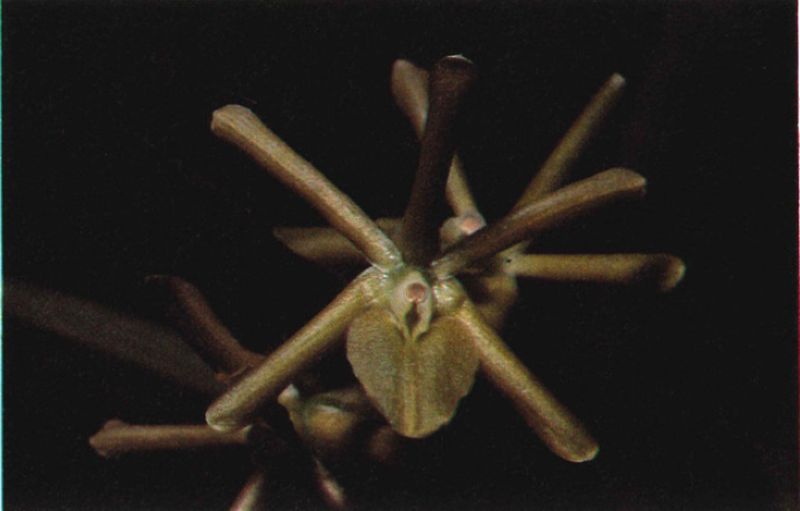

Epidendrum flexicaule Schltr. 1918 GROUP Ramosum SUBGROUP Flexicaule
Photo by © Eric Hagsater/Drawing by M Jimenez and The Herbario AMO Website
TYPE Drawing by © Werckle and The Epidendra Website





Common Name or Meaning Flexuous Stem Epidendrum
Flower Size .8" [2 cm]
Found in Costa Rica on the Pacific slope in rain and cloud forests at elevations around 750 to 1800 meters as small sized, warm to cool growing epiphyte with creeping, branching, successive, cane-like, flexuous, terete stems carrying numerous, all along the stem, linear-elliptic, bilobed leaves that blooms in the fall on a terminal, arising on the main stem and the secondary stem, racemose, distichous, .8 to 1.6" [2 to 4 cm] long including the very short peduncle, laxly, simultaneously 2 to 3 flowered inflorescence with slightly shorter to longer than the ovary, conduplicate, ovate floral bracts and carrying nocturnally scented, green becoming orange brown with age, flowers that have the lip always facing the rachis.
Recognized by the linear-elliptic, 3.28" x .32" [8.2 x .08cm] long leaves that blooms with sweetly fragrant, green flowers that turn brown to orange in time, the sepals are .36" to .48" [.9 to 1.2 cm] long, the petals are progressively expanding towards the rounded apex, and the lip is extended and widely ovate-cordiform with a rounded apex but it is medianally constricted.
"Epidendrum flexicaule belongs to the GROUP Ramosum which is characterized by the monopodial, branching stems, the spikelike, distichous inflorescence, and the single callus, and the SUBGROUP Flexicaule which has a stragling plant habit, where the main stem is not very evident, and the sepals have a dorsal keel which is generally prominent. The species is recognized by the long, narrow, linear-elliptic leaves up to 3.28 x .32" [8.2 x 0.8 cm] leaves, and has very similar copper-green though larger flowers, the sepals .36 to .48" [9 to 12 mm] long and a wide lip, .28 x .24" [7 x 6 mm], the floral segments rounded at the apex. It is similar to Epidendrum stevensii which is vegetatively very similar, the smaller, green flowers, sepals .24 to .32" [6 to 8 mm] long, acute floral segments, with the lip triangular, narrowed above the middle, apex acute. Epidendrum ramosum has consistently shorter « 2" [5 cm], wider leaves up to .6" [15 mm], the relatively large green flowers, sepals .44" [11 mm] long, the lip constricted below the middle, .264 x .18" [6.4 x 4.5 mm], and the deep nectary without forming a prominent vesicle. Epidendrum veraguasense Hágsater from Panama, has large, white flowers, a larger lip, .32 x .24" [8 x 6 mm], constricted above the middle, and the nectary only penetrates half the ovary and forms a prominent vesicle behind the perianth." Hagsater etal 2008
Synonyms
References W3 Tropicos, Kew Monocot list , IPNI ; Repert. Sp. Nov. Regni. Veg. Beih. 19: 212. Costa Rica Schlechter 1923; Orquídea (Méx.) 12(2) 1992. photo/drawing fide Icones Plantarum Tropicarum Plate 1523 Atwood 1993 drawing fide; Icones Orchidacearum 3 Plate 366 Hagsater 1999 see recognition section; Manual de las Plantas de Costa Rica Vol 3 Hammel, Grayum, Herrera and Zamora 2003; Icones Orchidacearum 9 Plate 948 Hagsater 2007 see recognition section; Icones Orchidacearum 11 Plate 1123 Hagsater & Sanchez 2008 drawing fide; Icones Orchidacearum 11 Plate 1144 Hagsater 2008 see recognition section; Icones Orchidacearum 11 Plate 1183 Hagsater 2008 see recognition section; Icones Orchidacearum 11 Plate 1195 Hagsater 2008 see recognition section; Icones Orchidacearum 13 Plate 1327 Hagsater & Santiago 2010 See recognition section; Icones Orchidacearum 16[2] Plate 1669 Hagsater & Sanchez 2018 see recognition section;
--------------------------------------------------------------------------------------------------------------------------